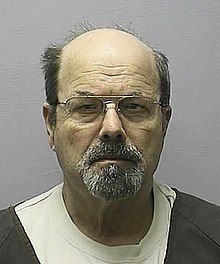Serial Killers
The Extreme Narcissism of Serial Killer BTK
Here are revelations from correspondence with Dennis Rader.
Posted February 12, 2024 Reviewed by Davia Sills
Key points
- Narcissism is an antisocial personality disorder, frequently found among serial killers who crave notoriety.
- Dennis Rader's narcissism is revealed in his correspondence.
- Rader rejects the classification of serial killer as too limiting to encompass the “accomplishments” of BTK.
- Rader claims the lengthy cooling-off period between his murders saved lives, and society should be grateful.

Narcissism is considered to be an antisocial personality disorder, and it is frequently manifested among serial killers, some of whom crave public notoriety. One such example is Dennis Rader, the serial killer better known by his self-assigned pseudonym of “Bind, Torture, Kill” (BTK). Rader killed 10 people, including men, women, and children, between 1974 and 1991. The following, which is drawn from my actual correspondence with him over a three-year period while researching a book, provides my thoughts on Rader’s profound narcissism, which is demonstrated in a number of ways.
Rader admits that he eagerly contributed to the construction of his own gruesome public identity when he instructed his pursuers to call him “Bind, Torture, Kill” in October 1974. He concluded his first letter to authorities with the postscript, “PS — Since sex criminals do not change their M.O. or by nature cannot do so, I will not change mine. The code word for me will be… Bind them, torture them, kill them, B.T.K., you see he’s at it again. They will be on the next victim.”
His chilling and self-assigned pseudonym of BTK described both his modus operandi (bind, kill) and his signature (torture). A self-proclaimed student of the killing game, Rader read the accounts and techniques of notorious serial killers that preceded him. He craved the infamy attained by the Son of Sam, the Boston Strangler, and Jack the Ripper, so he created a brand name for himself that would shock and terrorize society.
His creation of a unique BTK symbol (hand-drawn on letters) to authenticate his communications with the police, while unusual, was taken directly from David Berkowitz, who drew an occult symbol on one of his “Son of Sam” letters to the news media. Following his seventh murder, Rader sent a letter to authorities where he asked, “How many do I have to kill before I get a name in the paper or some national recognition?” This statement indicates just how much he craved attention for himself.
He was also fully aware of society’s fascination with the macabre, given the notoriety attained by other serial killers. Rader has said that he knew the public would be riveted by his crimes and would demand to know his motivations. Therefore, he deliberately appealed to society’s appetite for murder. Through his taunting letters and clues, Rader was speaking directly to his public audience.
Another indication of his narcissism is that Rader rejects the classification of serial killer for himself. He sees it as too limiting to encompass the many “accomplishments” of BTK. Rader explained to me that, unlike most serial killers who target a particular type of victim, such as a young female prostitute, BTK killed men, women, and children with equal pleasure and disdain. He reasons that no one in society could feel safe while he was on the loose because literally anyone could become his next victim.
Rader believes that his BTK alter ego was more like an armed terrorist (such as Osama bin Laden) than a serial killer. He also fancies himself a natural-born predator who is no more responsible for killing than a venomous snake or a shark. In fact, he attempts to neutralize any responsibility for his murders by claiming that he was compelled to kill by something he calls “Factor X”—that is, an insatiable and undeniable urge to kill that he does not comprehend. Rader is completely unrepentant today and has no remorse or regrets except for having been caught.
Another compelling example of his narcissism was revealed to me when I received a postcard from Rader that featured a colorful and striking original painting of a floral arrangement. It was a gift to me that has a fascinating little history. It seems that he received this postcard from a female admirer, Dana Sue Gray, who just happens to be a female serial killer serving a life sentence without the possibility of parole in California. She apparently is lonely and somewhat smitten by Rader, so she made contact with him through the mail by way of the postcard. Rader, however, was not equally impressed by her. Therefore, he re-gifted the postcard to me and explained that she simply was not in his league. Dana Sue Gray only killed three people and wounded another before being caught. Apparently, a prolific serial killer such as Rader needs to have certain minimum standards met before dating.
Rader’s narcissism is also manifested in his musings about the cooling-off period in between his murders. Unlike most serial killers, BTK had a reign of terror that lasted an unusually long time. He started killing in 1974, when he was 28, and was planning another murder at the time of his arrest in 2005 when he was 59. Rader engaged in autoerotic fantasy and masturbation, aided by trophies such as clothing from his victims to relive his crimes in order to satisfy his powerful sexual cravings in between murders.
As a result of his autoerotic fantasy life, the length of time or cooling off period between BTK’s murders was highly variable and generally much longer than most other serial killers. Incredibly, Rader takes credit for his fantasy rituals and even claims that they saved lives. He explained to me that he likely would have killed more people if he had not discovered a way to satisfy his urges. In one of his letters to authorities, he wrote, “I can’t stop it so, the monster goes on, and hurt me as well as society. Society can be thankful that there are ways for people like me to relieve myself...” He seems to believe that society owes him a debt of gratitude for not killing more frequently than he did. This is another example of his twisted narcissistic reasoning that almost defies comprehension.




